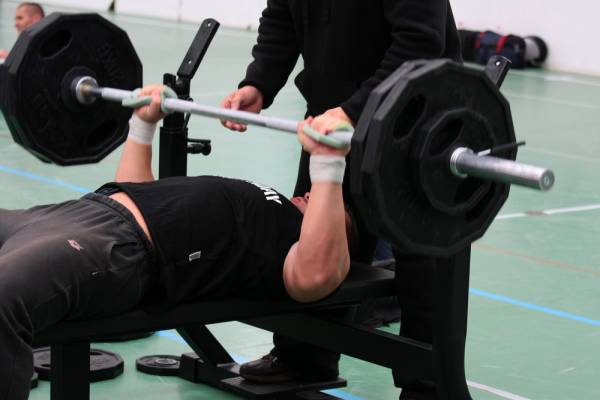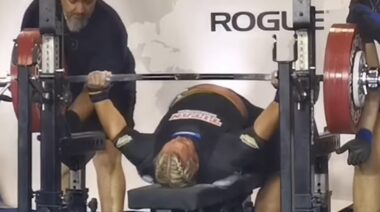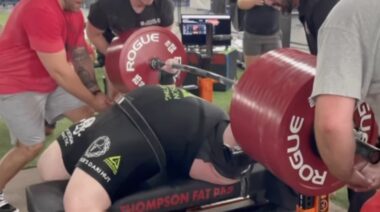Coming up through the fitness-ranks over the last twelve years, starting as a teen-bodybuilder, then a competitive sprinter, and now a CrossFit addict, I’ve never been asked a singular fitness question more than, “What do you bench?” However, having heavily pursued functional fitness for the last three years, I realized I hadn’t been asked that question in over 36 months. Until recently. When I was once again asked, I must have had a blank-stare on my face, because the next question was, “You do bench, right?”
I wanted to tell this individual so many things. I wanted to tell him about functional fitness, or fitness in general for that matter, and how it could be defined and what real strength was. But the only response that came to mind was, “I got 99 problems, but a bench ain’t one.”
The bench press can be a great exercise. It will help you work towards good solid upper body strength and a bigger chest, but it also commonly leads to shoulder, wrist, and back injuries when performed or programmed incorrectly. So if you insist on benching, here’s what I advise:
7 Ways to Make Sure Bench is Not a Problem
1. Listen to Zatsiorsky
First, let’s start with how to effectively add the bench press into your routine. This is assuming you want to focus on and increase your bench press rapidly. Vladimir Zatsiorsky wrote an amazing book that should be on the bedside table of any serious weight lifter or fitness guru, Science and Practice of Strength Training, Second Edition. I don’t want to bore you, but in this book Zatsiorsky discusses the three main ways to build strength: the maximal effort method, the submaximal effort method, and the dynamic effort method.
Here is a brief explanation of each:
- Maximal Effort Method – lifting a maximum load.
- Submaximal Effort Method – lifting a load smaller than maximal effort a repeated number of times.
- Dynamic Effort Method – lifting a submaximal load at maximal velocity.
To get serious about the bench press you need to incorporate all three methods. The most often overlooked is the dynamic effort method.
2. Plant the Feet
The feet should be set before leaning back to begin the bench press. Plant your feet in a solid position, and after they are set do not move them. If you have a tendency to raise your butt/lower back off of the bench when you bench press, try a wider foot position as opposed to a narrow position with feet under the bench.
3. Bob, But Don’t Weave
When you begin the lift do not press towards the rack on your way up. I use the coaching cue, “bob, don’t weave,” to indicate the athlete should press straight up and bring the bar straight down, and not at an angle back towards the rack. Lifting in this “weave” motion can more than double the distance the bare travels, thus making you appear much weaker than you actually are.
4. Elbows In
A majority of what you may see in commercial gym today, is an elbows out pressing motion, and is what can lead to injury most easily. You must keep the elbows in with the bar over your wrists, so as to engage the lats in the bottom position.
5. Press With the Lats
In the bottom position you should not let your joints and shoulders take the brunt of all the weight you are lifting. Control the weight at the bottom, keep the elbows in, and engage your chest, lats, and triceps for the press. Using bigger muscles means lifting bigger weights – deltoids aren’t much in comparison to the lats.
6. Stay Tight
The whole body should be tight during the bench press. Tighten your quads, your abdominals, and all muscles involved in the pressing motion. It helps to squeeze the bar as tight as you can, as this has a tendency to keep the rest of your body tight.
7. Don’t Forget the Triceps
Don’t forget to add in movements like the close grip bench press to help get stronger triceps. A big chest is not the key to a big bench press. The key is training the right muscles with the right lifts, i.e. pecs, lats, and triceps.
Now you know how to do it, but do you need to do it? This may be the only article you ever read that tells you how to bench press, but then tells you not to bench press. Unless bench press is your sport (powerlifting) there is not much use to heavily incorporating the bench press into your training routine. That’s right, I said it. The bench press, while useful, is not functional, and can be one of the most dangerous lifts in the gym. The risk to reward is very little considering how many other exercises there are to build the chest, triceps, and shoulders.
 My official recommendation is not to actually quit the bench press altogether, but to perfect the bench press by incorporating some of the tips listed above. Start benching less and add safer functional methods to your training that don’t wreak havoc on your rotator cuff and pecs. I have found if I apply the tips provided above, in an attempt to perfect the bench press movement, yet add other more functional movements into my routine, I can bench press roughly once a month and maintain my same max effort bench press.
My official recommendation is not to actually quit the bench press altogether, but to perfect the bench press by incorporating some of the tips listed above. Start benching less and add safer functional methods to your training that don’t wreak havoc on your rotator cuff and pecs. I have found if I apply the tips provided above, in an attempt to perfect the bench press movement, yet add other more functional movements into my routine, I can bench press roughly once a month and maintain my same max effort bench press.
I am not saying you only need to work out once a month. There are a lot of muscles involved in the bench press and training these muscles in a functional fashion can keep bench press strength levels consistent, if not improve them drastically. There is no secret here. Regularly incorporate pressing movements such as the standing barbell press, push press, push jerk, barbell rows, and many different variations of the push-up. That’s it.
If you must bench press, do so perfectly, and infrequently. Focusing on form and function will make you strong, and while you may have 99 problems – the bench won’t be one.
Photos courtesy of Shutterstock.






